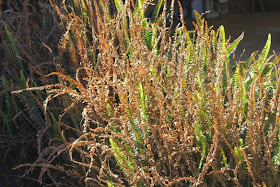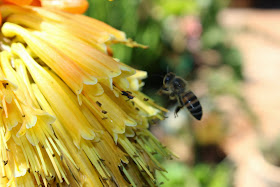I used to have stretches of this wonderful ground-cover in my last garden. This easy-to-grow succulent, native to South Africa, is a wonderful ground-cover, ideal for low-maintenance and water-wise gardens.
There are seven species and two subspecies of the genus Carpobrotus (family Membryanthemum), also known as Sour Fig, in South Africa and another five in the rest of the world. Leaves are eaten by tortoises. Puff-adders and other snakes such as the Cape Cobra are often found in Carpobrotus clumps where they ambush the small rodents that are attracted by the fruits. Flowers are pollinated by solitary bees, honey bees, carpenter bees and many beetle species. Flowers are eaten by antelopes and baboons. The clumps provide shelter for snails, lizards and skinks, so it’s a wonderful plant to have if you want to attract wildlife to your garden.
CARPOBROTUS (Also called the Hottentot Fig)
C.
acinaciformis (sour fig, elandsvy, goenavy, Hotnotsvy, strandvy, suurvy ) has purple flowers, robust, short, greyish green, sabre-shaped leaves and tasty edible fruits, used to make a delicious jam, and grows in coastal sands usually close to the sea, in the Western Cape, from Saldanha to Mossel Bay (South Africa).
Carpobrotus juice (from leaves) can be used as a mild astringent. When mixed with water the juice can be used to treat diarrhoea, dysentery and stomach cramps. It can also be used as a gargle for sore throat and laryngitis, and mild bacterial infections of the mouth. The leaf juice can also be used externally, much like Aloe Vera for burns, abrasions, open cuts, grazes, mosquito bites and sunburn. It is also used to treat ringworm, eczema, dermatitis, herpes, thrush, cold sores, cracked lips, chafing, skin conditions and allergies.
It can also be used to soothe Bluebottle (Physalia utriculus) stings when at the beach. Break open the leaves of Carpobrotus, apply the aloe-like gel to the sting area but be
careful not to rub the affected area. One will experience almost
immediate relief.
CONSERVATION STATUS
Carpobrotus edulis is not regarded as threatened in its native habitat, but it is invading natural areas in other parts of the world and threatening the survival of other species. In California, where it has been used since the early 1900s to stabilize the soil along railway tracks and roadsides and as a garden ornamental, it has naturalized and is invading coastal vegetation from north of Eureka to Rosarita Bay. It is known as the highway ice plant in the USA. It has naturalized along the west coast of Australia from Perth to Albany where it was also used for soil stabilization and is known as pigface. It has naturalized in parts of the Mediterranean and on the south coast of England.
The fruit of Carpobrutus
acinaciformis, C.
deliciosus and C.
edulis is tasty and sought after by humans and I found this jam recipe on the internet :
SOUR FIG WHOLE FRUIT JAM
1.5kg of desicated fruit of C.
acinaciformis
1.5kg sugar
2L water
45ml lemon juice
A few pieces of cinnamon
Remove floral parts and loose particles. Ends hould be cut off flush, not too deep so that the seeds don't boil out. Soak fruit over-night in a weak brine solution until soft. Rinse fruit and peel skin.
Bring fruit quickly to the boil in fresh water. Boil other ingredients together until mixture reaches syrup consistency. Add fruit to syrup. Boil mixture until fruit becomes soft but not pulpy.
The jam should have an attractive dark colour. Seal hot jam in sterilised bottles.
To make a smooth jam or jelly, use above recipe, mince fruit and cook until soft and gelatinous.
Enjoy!
.













































